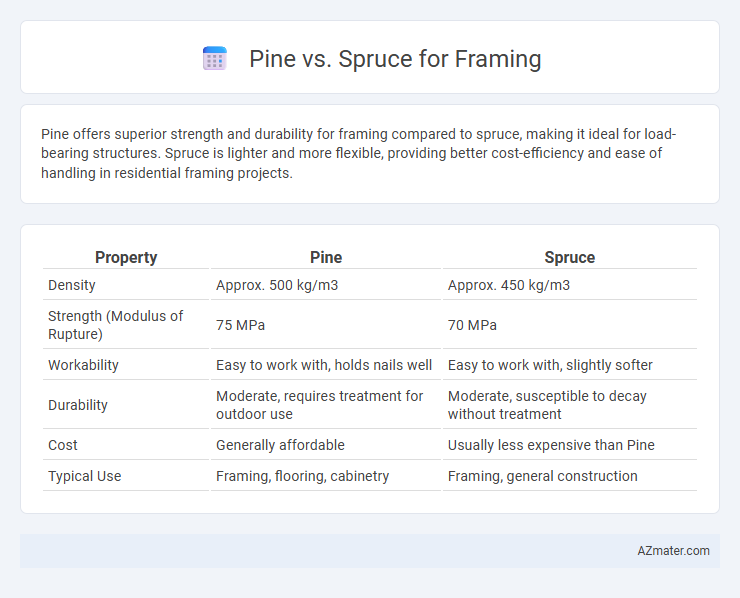Pine offers superior strength and durability for framing compared to spruce, making it ideal for load-bearing structures. Spruce is lighter and more flexible, providing better cost-efficiency and ease of handling in residential framing projects.
Table of Comparison
| Property | Pine | Spruce |
|---|---|---|
| Density | Approx. 500 kg/m3 | Approx. 450 kg/m3 |
| Strength (Modulus of Rupture) | 75 MPa | 70 MPa |
| Workability | Easy to work with, holds nails well | Easy to work with, slightly softer |
| Durability | Moderate, requires treatment for outdoor use | Moderate, susceptible to decay without treatment |
| Cost | Generally affordable | Usually less expensive than Pine |
| Typical Use | Framing, flooring, cabinetry | Framing, general construction |
Introduction to Pine and Spruce as Framing Lumber
Pine and spruce are two of the most common softwoods used in framing lumber due to their strength, availability, and workability. Pine offers a slightly higher density and better nail-holding capacity, making it favorable for structural support and load-bearing applications. Spruce, often lighter and more uniform in texture, provides consistent dimensional stability and ease of cutting, which is ideal for precise framing tasks.
Botanical Differences: Pine vs Spruce
Pine and spruce differ botanically in needle arrangement and cone structure, with pine needles growing in clusters of two to five, while spruce needles are singly attached and sharper. Pine trees, belonging to the genus Pinus, have thicker bark and resin canals that aid in durability for framing applications. Spruce, from the genus Picea, features smoother bark and more flexible wood fibers, influencing its structural performance in construction projects.
Density and Strength Comparison
Pine offers moderate density ranging from 350 to 560 kg/m3, providing reliable strength suitable for framing applications, while spruce typically has a lower density between 400 and 450 kg/m3 with slightly less compressive strength. Pine's higher Janka hardness, averaging around 690 lbf, ensures better resistance to dents and structural stress compared to spruce's 510 lbf. For framing projects requiring greater load-bearing capacity and durability, pine is often preferred due to its superior density and strength characteristics.
Workability and Ease of Use
Pine offers superior workability for framing due to its softer texture and straight grain, making it easier to cut, nail, and shape without splitting. Spruce, while also lightweight and strong, tends to have a finer grain but can be more brittle, requiring careful handling during installation. Both woods are widely used in construction, but Pine's ease of use often results in faster framing and reduced labor effort.
Moisture Resistance and Durability
Pine framing lumber generally offers better moisture resistance compared to spruce due to its denser grain structure, which helps reduce water absorption and shrinkage. Spruce tends to be less durable in moist environments, making it more prone to warping and rot over time. For construction projects requiring long-term durability and moisture management, pine is often the preferred choice to ensure stable and resilient framing.
Cost Analysis: Pine vs Spruce
Pine generally offers a lower cost for framing compared to spruce due to its faster growth rate and wider availability, making it a budget-friendly choice for large construction projects. Spruce, although slightly more expensive, provides superior strength-to-weight ratio, which can lead to savings in structural support materials and labor. Analyzing regional price variations and wood treatment costs is essential for an accurate cost comparison between pine and spruce in framing applications.
Environmental Impact and Sustainability
Pine and spruce wood both offer sustainable options for framing due to their rapid growth and wide availability in managed forests, contributing to lower environmental impact compared to slower-growing hardwoods. Pine generally has a higher resin content, enhancing durability and reducing the need for chemical treatments, which benefits ecological health during construction and disposal. Spruce, with its lower density and lighter weight, requires less energy for transportation, further minimizing carbon emissions in the supply chain.
Common Applications in Framing
Pine and spruce are both popular choices for framing due to their strength and workability, with pine often preferred for residential construction because of its wider availability and ease of handling. Spruce is commonly used in light framing projects and roof trusses, valued for its straight grain and consistent density. Both species provide good structural support, but pine tends to be slightly more durable and resistant to decay, making it a frequent selection for load-bearing applications.
Regional Availability and Sourcing
Pine is widely available in North America and Europe, making it a common choice for framing projects due to its abundance and cost-effectiveness. Spruce, particularly Sitka spruce, is more regionally concentrated in the Pacific Northwest and parts of Canada, often valued for its strength-to-weight ratio in construction. Sourcing pine tends to be easier and more affordable in diverse markets, while spruce may require targeted procurement depending on geographic location and project requirements.
Which is Better for Your Framing Project?
Pine is generally preferred for framing due to its balance of strength, ease of workability, and affordability, making it ideal for structural support in residential and commercial construction. Spruce offers a lighter weight option with good strength but tends to be less durable and more prone to warping, which might affect long-term stability in framing projects. Choosing pine for framing ensures better load-bearing capacity and minimal shrinkage, crucial factors for maintaining the integrity of walls and roofs.

Infographic: Pine vs Spruce for Framing
 azmater.com
azmater.com